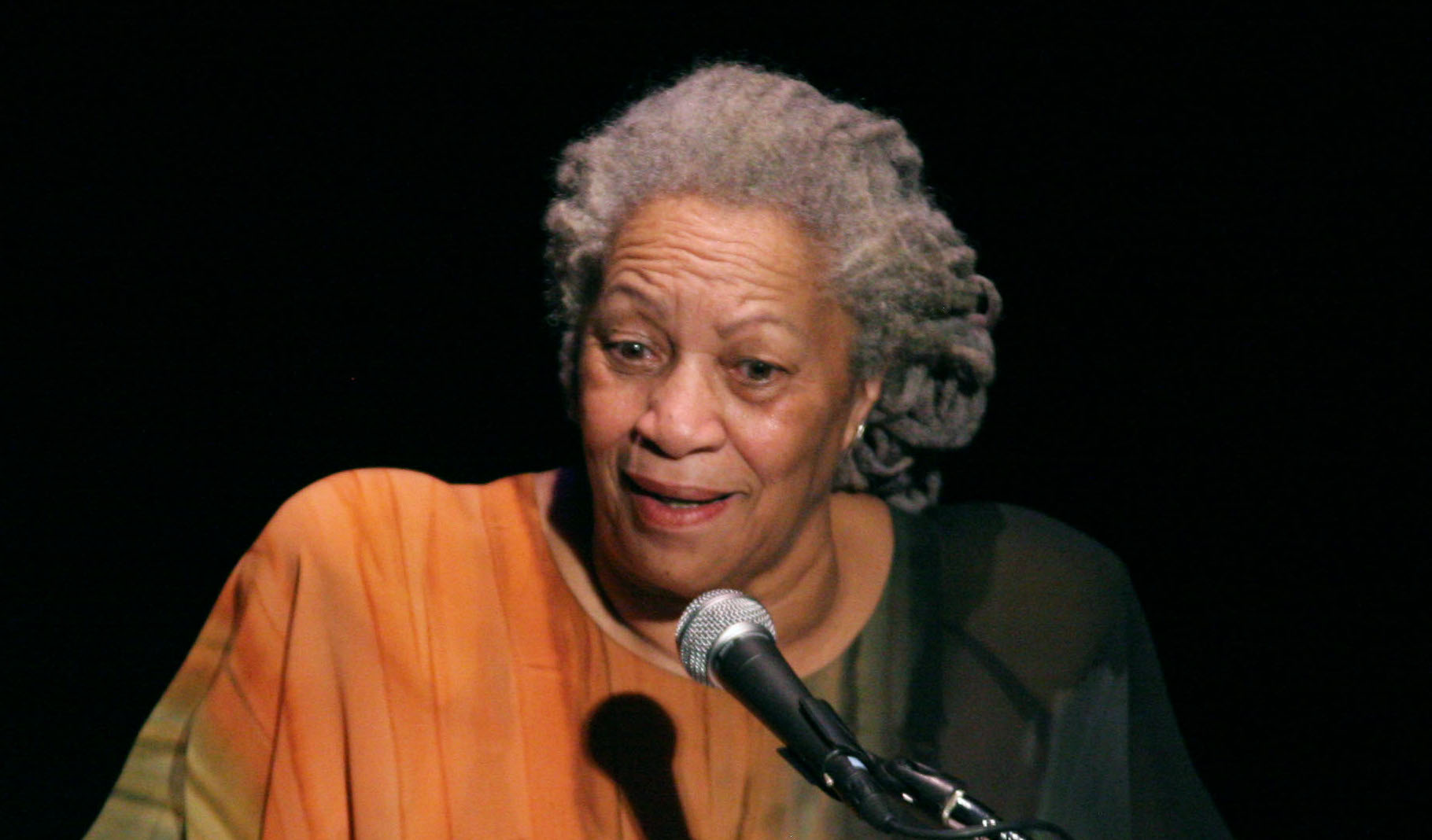Jane Ciabattari on Toni Morrison’s ‘A Mercy’
An unabashed triumph, Morrison's new novel is a gloriously poetic and incantatory retelling of America's tragic and redemptive story. Toni Morrison speaking at ‘A Tribute to Chinua Achebe: 50 Years Anniversary of Things Fall Apart‘, 2008, New York. Image via Angela Radulescu/Creative Commons.
Toni Morrison speaking at ‘A Tribute to Chinua Achebe: 50 Years Anniversary of Things Fall Apart‘, 2008, New York. Image via Angela Radulescu/Creative Commons.
Toni Morrison’s glorious new novel, “A Mercy,” continues her poetic and purgative retelling of the story of America. Morrison’s body of work, which has brought her a Pulitzer (for “Beloved” in 1988) and the 1993 Nobel Prize, has populated our literature with an extraordinary cast of characters, from Pecola, the 11-year-old black girl impregnated by her father, who still dreams of having the blond hair and blue eyes that she visualizes as the ideal in Lorain, Ohio (“The Bluest Eye,” 1970), and Sula, whose path from small-town rebel to pariah contrasts with her best friend’s conventional choices (“Sula,” 1974), through Sethe, the fugitive slave who murders her own daughter rather than allow her to be taken back to bondage (“Beloved,” 1987).
Like “Beloved,” which drew us into the vortex of slavery’s vicious aftermath in the years just after the Civil War, “A Mercy” is a “rememory” — a ritual repetition of trauma powered by incantatory prose and searing images. This time Morrison trains her laser focus on a little-known period of slavery during the 17th century, a time of great cultural conjunction on the North American continent, when indentured servants from Europe, native peoples and African-born slaves were the serving class to a small group of landed gentry.
Like most Americans, Morrison was unaware until recently that many white Americans are descended from slaves. When white indentured servants from Europe arrived in Virginia in 1619, at the same time as the first African-born slaves, their status was roughly equivalent. “The only difference between African slaves and European or British slaves was that the latter could run away and melt into the population. But if you were black, you were noticeable,” she told NPR. And so the European-born settlers along the mid-Atlantic coast where Morrison sets “A Mercy” were not just landowners, but also indentured servants given the choice of jail or exile, men working off debts or prison terms, prostitutes, poverty-stricken women and homeless children who survived the perilous voyage to the New World.
Florens, the Angolan-born slave narrator in “A Mercy,” shares with other Morrison heroines an oblique means of telling her story. She has only vague memories and dreams of her mother but survives by her own instincts, intuitions and signs from the natural world, even shape-shifting. When we meet Florens in the opening lines of the novel, her most ghastly transformation is behind her. “Don’t be afraid. My telling can’t hurt you even in spite of what I have done and I promise to lie quietly in the dark — weeping perhaps or occasionally seeing the blood once more — but I will never again unfold my limbs to rise up and bare teeth.”
This opening passage plunges us willy-nilly into a mystery. Where is she? Who is she? What has she done? And soon enough we learn the year is 1690. Florens is a young woman, one of two black slaves on a Protestant settler’s plantation (there also are a Native American slave, and two white indentured servants who probably never will be free). The master, Dutch-born Jacob Vaark, has just died of pox; and the mistress, Rebekkah, has caught it and may be dying. Florens is sent through the wilderness to find a free black man, a blacksmith and healer whose wizardry may cure her. But it is Florens’ binding passion for the blacksmith more than her mistress’ dire illness that drives her.
Florens’ first-person account of her journey through perilous wilderness, the spine of the novel, is interspersed with third-person set pieces following the other major characters. Morrison begins with Jacob Vaark, whom we first meet in 1682 as he rides along the Lenape trail with a sense of awe. “Breathing the air of a world so new, almost alarming in rawness and temptation, never failed to invigorate him. Once beyond the warm gold of the bay, he saw forests untouched since Noah, shorelines beautiful enough to bring tears, wild food for the taking. … Now here he was a ratty orphan become landowner, making a place out of no place, a temperate living from raw life.”
Vaark finds his way to the Virginia plantation of a former Portuguese slave trader who owes him money. Even though he is revolted by the thought, Vaark reluctantly accepts the offer of a human slave as partial payment of the debt. A well-fed woman with two young children catches his eye. Sensing his sympathetic nature, the woman offers him Florens in her stead. “Please, Senhor. Not me. Take her. Take my daughter,” she says. Jacob Vaark, struck by the terror in her eyes, thinks, “God help me if this is not the most wretched business.”
Vaark is a decent man, uncomfortable with the “thicket of new laws” Virginia had passed a half-dozen years before — a harsh crackdown after a revolt waged by “blacks, natives, whites, mulattoes — freemen, slaves, and indentured.” These laws eliminated manumission (the right to buy one’s freedom), gatherings, travel and bearing arms for black people only, granted license to any white to kill any black for any reason, compensated owners for a slave’s maiming or death. “They separated and protected all whites from all others forever,” Morrison writes, identifying a historic turning point, the first in a series of laws that divided Americans one from another on the basis of skin color for centuries to come. In Jacob Vaark’s view, these were “lawless laws, encouraging cruelty in exchange for common cause, if not common virtue.” Nevertheless, he accepts the slave girl, and adds Florens to others who help his wife, Rebekkah. And so a haphazard household assembles.
“A Mercy” harks back to the precise and potent language of Morrison’s first novel, “The Bluest Eye.” “A Mercy” is a compact book, under 200 pages. It’s not the tragic opera that “Beloved” is, but rather a chamber piece, with each voice carrying a clear narrative line. It is astonishing how freshly Morrison evokes this chorus of voices to transport us into a time in which the North American continent was still the Old World to the tribes that lived there first. There is Lina, the native woman whose village had been wiped out by pox, sold by “kindly Presbyterians” to Vaark (“Sir,” she calls him). Lina has “cobbled together neglected rites, merged Europe medicine with native, scripture with lore, and recalled or invented the hidden meaning of things.” A lifeline in the wilderness to Vaark and Rebekkah, the wife he purchases from her parents in England, Lina has preserved knowledge of how to follow “the majestic plan of life: when to vacate, to harvest, to burn, to hunt. … ” At first a rival, she becomes Rebekkah’s protector, midwife to the children she bears and loses, one by one, and a maternal comfort to Florens. It is Lina who sees Sir’s building of a manor house requiring “the death of fifty trees” as courting misfortune, and who recognizes that Florens’ lust for the blacksmith is foolhardy, if not dangerous.
And there is tragic Sorrow — vixen-eyed, with “black teeth and a head of never groomed wooly hair the color of a setting sun,” Sorrow, who was raised aboard a ship and survived its wreck, to be found half-drowned and half-daft in Mohawk country and nursed back to life, her only stability her spectral companion, Twin.
Willard and Scully, the two whites, are indentured servants whose time has been extended. Scully was the son of a woman sent off to the colonies for “lewdness and disobedience.” Upon her death, her contract was transferred to Scully. Then a man claiming to be his father leased him for an unspecified time. Willard, who has a fatal fondness for rum, had worked the Virginia tobacco fields, one of 23 men — “six English, one native, twelve from Africa by way of Barbados.” By contrast, he and Scully found on Jacob Vaark’s land “the closest either man would know of family. A good-hearted couple (parents), and three female servants (sisters, say) and them helpful sons.”
These are the witnesses, companions and chorus to Florens’ meandering tale. On her mission, she encounters a group of young native men on horseback who give her water and food, and barely escapes witch hunters who perceive her as a devil. She at last tracks down the blacksmith in an encounter both shocking and preordained.
Reading “A Mercy,” it’s suddenly possible to imagine a continent stretching westward from the Atlantic inhabited by thousands of tribal people whose languages and customs vary from forest to plains to mountain to desert to the far Pacific coast. A sort of Eden, as yet unmarked by pox or conquest. The setting for “A Mercy” was originally home to the Lenape, who were among the first to come into contact with the “Europes.” A nomadic tribe known as peacemakers as well as fierce warriors, the Lenape had lived along the Delaware River for thousands of years. The newcomers from Europe brought with them diseases and beliefs that eventually decimated the Lenape along with most of the rest of the native population of the continent. As the knowing Lina predicts, “Cut loose from the earth’s soul, they insisted on purchase of its soil, and like all orphans they were insatiable. It was their destiny to chew up the world and spit out a horribleness that would destroy all primary peoples.”
But in the beginning, the possibility of harmonious coexistence, even collaboration, existed. This may be why there is, oddly, more hope, less pain in “A Mercy” than in “Beloved” and other Morrison novels. A possibility of redemption hovers over these early American scenes as Lina and Rebekkah become friends as “together, through trial and error, they learned,” as Jacob and the blacksmith work on the new house, bending their heads over lines drawn in the dirt and sharing an apple, as Willard and Scully deliver Sorrow’s baby. “A Mercy” creates an eerie aura of an alternative future, a “what if” imagining of another New World. What would have happened if the 17th-century laws defining slavery by skin color, making lifelong servitude for black slaves mandatory, and all those others that followed, had not been passed? And, embedded even deeper in Morrison’s questing text, in Lina’s story, what if the “Europes” had been able to coexist with and learn from those who first lived on this continent? What sort of country would we have made together?
But Morrison, ever the tough-minded realist, offers only a whiff of this fragile possibility before she brings the curtain down with a profound and heart-wrenching final scene.
Jane Ciabattari is the author of the short story collection “Stealing the Fire” and president of the National Book Critics Circle.
Dig, Root, GrowThis year, we’re all on shaky ground, and the need for independent journalism has never been greater. A new administration is openly attacking free press — and the stakes couldn’t be higher.
Your support is more than a donation. It helps us dig deeper into hidden truths, root out corruption and misinformation, and grow an informed, resilient community.
Independent journalism like Truthdig doesn't just report the news — it helps cultivate a better future.
Your tax-deductible gift powers fearless reporting and uncompromising analysis. Together, we can protect democracy and expose the stories that must be told.
This spring, stand with our journalists.
Dig. Root. Grow. Cultivate a better future.
Donate today.









You need to be a supporter to comment.
There are currently no responses to this article.
Be the first to respond.